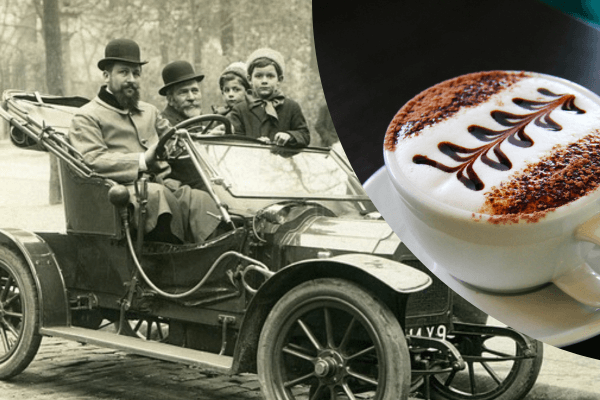The Industrial Revolution stands as one of the most transformative periods in human history. Spanning from the late 18th to the early 19th century, this era brought about unprecedented technological advancements, mechanization, and the establishment of factory systems.
It reshaped societies, economies, and cultures worldwide, propelling humanity into a new era of progress. Amidst this profound transformation, coffee emerged as a significant catalyst, fueling the rise of modern society and playing a pivotal role in shaping the course of the Industrial Revolution.
At the heart of the Industrial Revolution lay a relentless pursuit of progress, marked by innovations in machinery, manufacturing processes, and transportation systems. As industrialization spread across continents, so did the demand for a beverage that could sustain the labor force and keep up with the ever-increasing pace of production.
Coffee, with its invigorating properties, stepped into the spotlight as the ideal companion for the workers of the Industrial Revolution.
The Role of Coffee in the Industrial Revolution
Coffee’s role in the Industrial Revolution cannot be overstated. As factories multiplied, work hours extended, and the need for a diligent and alert labor force became paramount, coffee emerged as a vital fuel for productivity.
The stimulant properties of caffeine provided workers with the energy and focus necessary to endure long shifts and perform intricate tasks with precision.
In the early morning hours, workers would gather around communal coffee pots, sipping the hot brew that would awaken their senses and prepare them for a day of arduous labor.
The effects of coffee on productivity were noticeable, as it provided a much-needed boost, combating fatigue and enabling workers to meet the growing demands of industrial production.
Coffee as a Stimulant: Boosting Productivity and Workforce Efficiency
Coffee’s stimulating effects on the central nervous system played a crucial role in driving productivity during the Industrial Revolution. By increasing alertness, concentration, and mental acuity, coffee became the secret weapon behind the efficiency of the labor force.
It allowed workers to maintain focus even during monotonous and repetitive tasks, ensuring higher levels of output and quality. The widespread consumption of coffee in industrial settings not only boosted individual productivity but also fostered a collective sense of energy and camaraderie.
Workers would gather in designated break areas, coffeehouses, or factory canteens, bonding over shared cups of coffee and exchanging stories of their toil. Coffee became a unifying force, bringing workers together and reinforcing the spirit of collective endeavor that characterized the Industrial Revolution.
Coffeehouses: Gathering Places for Industrialists and Innovators
Coffeehouses emerged as vital institutions during the Industrial Revolution, serving as gathering places for industrialists, entrepreneurs, and innovators.
These establishments offered a unique environment that encouraged intellectual discourse, idea sharing, and networking. In the coffeehouses, individuals from different walks of life converged, transcending social barriers and engaging in conversations that would shape the course of industries and societies.
Coffeehouses became hubs of innovation, where inventors showcased their latest creations, businessmen struck deals, and intellectuals debated ideas that would fuel further progress.
These bustling spaces served as catalysts for collaboration, as the aroma of freshly brewed coffee mingled with the excitement of entrepreneurial spirit, giving birth to new ventures and accelerating the pace of industrial advancement.
Coffee and the Expansion of Global Trade Networks
The Industrial Revolution was characterized by the rapid expansion of global trade networks, and coffee played a significant role in this process. As demand for coffee grew exponentially, fueled by the industrial workforce and the rising middle class, trade routes extended to remote corners of the world.
Coffee cultivation and exportation became profitable ventures, creating economic opportunities for countries with suitable climates and fertile lands. Colonial powers recognized the potential of coffee as a lucrative commodity and established plantations in regions like Latin America, Africa, and Asia.
The cultivation and exportation of coffee bolstered international trade, contributed to the development of transportation infrastructure, and facilitated the integration of diverse cultures into the global market.
Coffee as a Social Equalizer: Breaking Class Barriers in the Industrial Era
Coffeehouses became social equalizers during the Industrial Revolution, providing a space where individuals from different social classes could gather on equal footing.
Within these establishments, factory workers, intellectuals, and entrepreneurs could engage in discussions, share ideas, and participate in the vibrant exchange of knowledge, irrespective of their social standing.
Coffee and the Rise of Café Culture in Urban Centers
The proliferation of coffeehouses during the Industrial Revolution led to the rise of café culture in urban centers. Coffeehouses became popular social destinations where people could gather, socialize, and enjoy a cup of coffee.
The emergence of café culture fostered a sense of community and camaraderie, providing a much-needed respite from the demanding industrial environment.
Coffee’s Influence on Working Conditions and Labor Movements
Coffee had a notable influence on working conditions and labor movements during the Industrial Revolution. As workers gathered in coffeehouses, they discussed their grievances, organized protests, and formed labor unions.
The Coffee shops became meeting places for labor activists, fostering solidarity and contributing to the advancement of workers’ rights.
Coffeehouses as Intellectual Hubs: Fostering Innovation and Exchange of Ideas
Coffeehouses served as intellectual hubs during the Industrial Revolution, facilitating the exchange of ideas and fostering innovation. These establishments attracted scholars, scientists, and thinkers, creating an environment conducive to intellectual discourse and the cross-pollination of ideas.
The coffeehouse culture played a crucial role in shaping intellectual advancements that drove the progress of the era.
Coffee and the Emergence of Coffee Plantations in Colonized Regions
The demand for coffee during the Industrial Revolution led to the establishment of coffee plantations in colonized regions. European powers sought to meet the growing demand by cultivating coffee in their colonies, contributing to the economic exploitation and transformation of these regions.
The coffee industry played a complex role in the history of colonization and global trade during this period.
Coffee’s Impact on Consumer Culture: From Coffeehouses to Coffee Brands
The Industrial Revolution marked the beginning of consumer culture, and coffee played a significant role in shaping this phenomenon. Coffeehouses evolved into branded establishments, and coffee became a symbol of modernity and sophistication.
The rise of coffee brands and the dissemination of coffee culture through advertisements and packaging reflected the growing influence of consumerism in society.
Coffee’s Influence on Urbanization and Social Dynamics
The Industrial Revolution was marked by rapid urbanization, as people flocked to industrial centers in search of employment opportunities.
Coffeehouses played a significant role in shaping the social fabric of these burgeoning cities. They became not only places for intellectual exchange but also centers of socialization, offering respite from the demanding and often isolating industrial work environment.
In coffeehouses, individuals from various social classes intermingled, transcending traditional hierarchies and fostering a sense of community. The egalitarian nature of these spaces allowed for the free flow of ideas and the formation of social bonds that cut across social divides.
Coffeehouses became microcosms of the changing societal dynamics, where intellectual discourse, cultural exchange, and social interaction thrived. The Industrial Revolution marked a turning point in human history, and coffee played an integral role in driving its progress.
From fueling the productivity of the labor force to serving as a catalyst for intellectual discourse, coffee became an essential component of the rise of modern society. Its stimulating properties, social significance, and economic impact helped shape the course of this transformative era.
As the factories roared and the wheels of progress turned, coffee permeated every aspect of industrial life, leaving an indelible mark on the landscape of the Industrial Revolution.
The Coffee Trade and its Economic Impact on Industrialization
The coffee trade played a crucial role in the economic transformation of the Industrial Revolution. As demand for coffee surged, it became a valuable commodity that fueled global trade networks. The cultivation and exportation of coffee created economic opportunities and contributed to the rise of industrialization.
Coffee plantations sprouted in various regions around the world, particularly in Latin America, Africa, and Asia. The expansion of coffee cultivation required significant labor, leading to the growth of plantation economies and the establishment of extensive supply chains.
This demand for labor not only influenced the workforce but also shaped migration patterns and demographic shifts.
The need to transport coffee quickly and efficiently led to advancements in transportation technology, such as the invention of steamships and improved shipping containers.
These advancements not only benefited the coffee trade but also laid the foundation for the transportation systems that would support industrialization on a larger scale.
The Role of Coffee in the Working Class Lifestyle
Coffee became an essential part of the working class lifestyle during the Industrial Revolution. As industrialization progressed, workers faced long and grueling hours in factories and mills. Coffee provided a much-needed energy boost and helped alleviate fatigue, enabling workers to endure the demanding labor.
Coffee breaks became a common practice in factories and workplaces, allowing workers to recharge and rejuvenate during their shifts. These breaks not only served as a physical refresher but also provided opportunities for social interaction and camaraderie among coworkers.
The shared experience of drinking coffee fostered a sense of solidarity and community among workers, creating a supportive environment in the face of challenging working conditions. Furthermore, the affordability and accessibility of coffee made it a staple in working-class households.
It provided a comforting and affordable beverage option for individuals and families striving to navigate the changing landscape of industrialization. The ritual of brewing and enjoying a cup of coffee at home became a cherished daily routine, offering a moment of respite and familiarity in the midst of rapid societal changes.
Coffee’s Influence on the Birth of Consumer Culture
The Industrial Revolution not only transformed production processes but also gave rise to consumer culture. Coffee played a significant role in shaping this new culture, becoming a symbol of progress, modernity, and social status.
As industrialization increased productivity and created a surplus of goods, a middle class emerged with newfound disposable income. Coffee became one of the first widely accessible luxury goods, and its consumption became synonymous with sophistication and refinement.
Owning coffee paraphernalia, such as coffee pots and cups, became a status symbol, signaling one’s participation in the emerging consumer culture. Coffeehouses also played a central role in fostering consumer culture.
These establishments became popular meeting places for individuals to see and be seen. The act of going to a coffeehouse became a social event, where people gathered to indulge in the pleasures of coffee and engage in leisurely activities.
This culture of consumption surrounding coffee fueled the growth of coffeehouses and created a demand for specialized coffee-related goods.
The Global Reach of Coffee: From Plantations to Coffeehouses
The global reach of coffee during the Industrial Revolution cannot be underestimated. From its origins in regions like Ethiopia and Yemen, coffee cultivation spread to colonies and territories under European powers.
Plantations were established in countries such as Brazil, Colombia, Java, and India, resulting in a global coffee trade network.
The coffee trade connected distant regions and cultures, contributing to the exchange of goods, ideas, and technologies. The influence of coffee extended beyond the plantations, as it made its way into coffeehouses that sprouted in major cities across the globe.
These coffeehouses became centers of socialization, intellectual discourse, and cultural exchange.
In Europe, coffeehouses became hubs for artists, writers, intellectuals, and entrepreneurs. They provided spaces for the exchange of ideas and the formation of intellectual movements.
Coffeehouses became known as places where individuals could engage in stimulating conversations, share knowledge, and challenge established norms.
The coffeehouse culture contributed to the dissemination of information and the cultivation of new perspectives, laying the foundation for the intellectual and cultural developments of the time.
Coffee Innovations and Technological Advancements during the Industrial Revolution
The Industrial Revolution brought about significant technological advancements, and the coffee industry was not exempt from innovation. Coffee production, preparation, and consumption underwent transformative changes during this period.
Technological advancements in coffee roasting and grinding equipment improved the efficiency and quality of coffee processing. Industrialized roasting machines allowed for larger-scale production, while grinding mills produced more consistent and finer coffee grounds.
These advancements not only increased the speed of coffee production but also enhanced the flavor and aroma of the final product.
In parallel, coffee brewing methods evolved to accommodate the demands of the growing population. Industrialization led to the development of coffee percolators, espresso machines, and drip brewing systems.
These innovations made coffee preparation more accessible, convenient, and efficient, catering to the needs of the fast-paced industrial society.
Moreover, advancements in packaging and transportation technology revolutionized the coffee trade. The introduction of vacuum-sealed containers and improved transportation methods allowed for the preservation and efficient distribution of coffee over long distances.
This facilitated the global expansion of the coffee trade and ensured a steady supply of coffee to meet the increasing demand of the industrializing world.
Coffee played a pivotal role in fueling the rise of modern society during the Industrial Revolution. Its economic significance, impact on the working class, influence on consumer culture, global reach, and technological advancements solidified coffee’s position as a catalyst for societal transformation.
From its humble origins to becoming a global commodity, coffee continues to be an integral part of our daily lives and a testament to its enduring legacy in shaping the modern world.
Conclusion
The influence of coffee during the Industrial Revolution was profound, shaping the trajectory of modern society in multifaceted ways. As a fuel for productivity, a catalyst for intellectual exchange, and a driver of economic growth, coffee played a pivotal role in the transformation of societies, economies, and cultures during this transformative period.
Coffee’s role in fueling the rise of modern society cannot be overstated. It became the lifeblood of the Industrial Revolution, sustaining the labor force and enabling workers to endure long hours of physically and mentally demanding tasks.
The stimulating properties of caffeine provided the energy and focus necessary for productivity, boosting the efficiency and output of the workforce.
As workers gathered around communal coffee pots or visited local coffeehouses, the aroma of coffee permeated the industrial landscape, becoming a symbol of endurance and the driving force behind progress.
The rise of coffeehouses during the Industrial Revolution served as hubs of intellectual discourse and social interaction. These establishments became melting pots of ideas, where intellectuals, entrepreneurs, and industrialists gathered to exchange knowledge, debate theories, and ignite innovation.
Coffeehouses provided a unique environment that fostered collaboration, transcending social hierarchies and creating spaces where the power of intellect took center stage.
The conversations that took place within these establishments shaped the course of industries, spurred advancements in science and technology, and propelled societies forward.
The global impact
Moreover, coffee’s impact on global trade during the Industrial Revolution cannot be overlooked. The demand for coffee soared, leading to the expansion of cultivation and trade networks. Colonial powers seized the opportunity, establishing coffee plantations in regions with suitable climates.
This fueled the growth of international trade, creating economic opportunities and shaping the geopolitical landscape. Coffee became not only a beverage but also a commodity that connected continents and cultures, forging global connections and contributing to the emergence of a truly interconnected world.
The influence of coffee extended beyond the realms of productivity and trade. It also played a significant role in shaping the social dynamics of the Industrial Revolution. As urbanization swept across the industrial centers, coffeehouses emerged as vital social institutions.
These spaces provided a haven from the rigors of industrial work, offering a place for individuals from diverse backgrounds to converge. Coffeehouses transcended social boundaries, fostering a sense of community and enabling the free flow of ideas.
They became melting pots of culture, where individuals from different walks of life found common ground and shared their experiences.
In addition to its social and economic impact, coffee became deeply ingrained in the fabric of everyday life during the Industrial Revolution.
It symbolized the spirit of progress and innovation that defined the era. Coffee became more than just a beverage; it represented a break from the past, a departure from traditional norms, and a taste of the modern world.
As workers gathered around their morning cup of coffee, it became a ritual, a moment of respite in a fast-paced and demanding industrial environment.
The Legacy
The legacy of coffee in the Industrial Revolution is still visible in the world we inhabit today. Coffeehouses continue to be vibrant centers of intellectual discourse and social interaction, providing spaces for collaboration and the exchange of ideas.
The influence of coffee on consumer culture remains strong, with coffee brands and cafes proliferating in cities around the globe. The expansion of global trade networks, initiated during the Industrial Revolution, has laid the foundation for the interconnected world we live in today. C
offee and the Industrial Revolution share a symbiotic relationship. As the Industrial Revolution propelled societies into the modern era, coffee fueled the rise of this transformative period. It provided the energy, inspiration, and social fabric necessary for progress.
Coffee’s role as a fuel for productivity, a catalyst for intellectual discourse, and a driver of economic growth solidified its place as a cornerstone of the Industrial Revolution and its legacy continues to shape our world.



